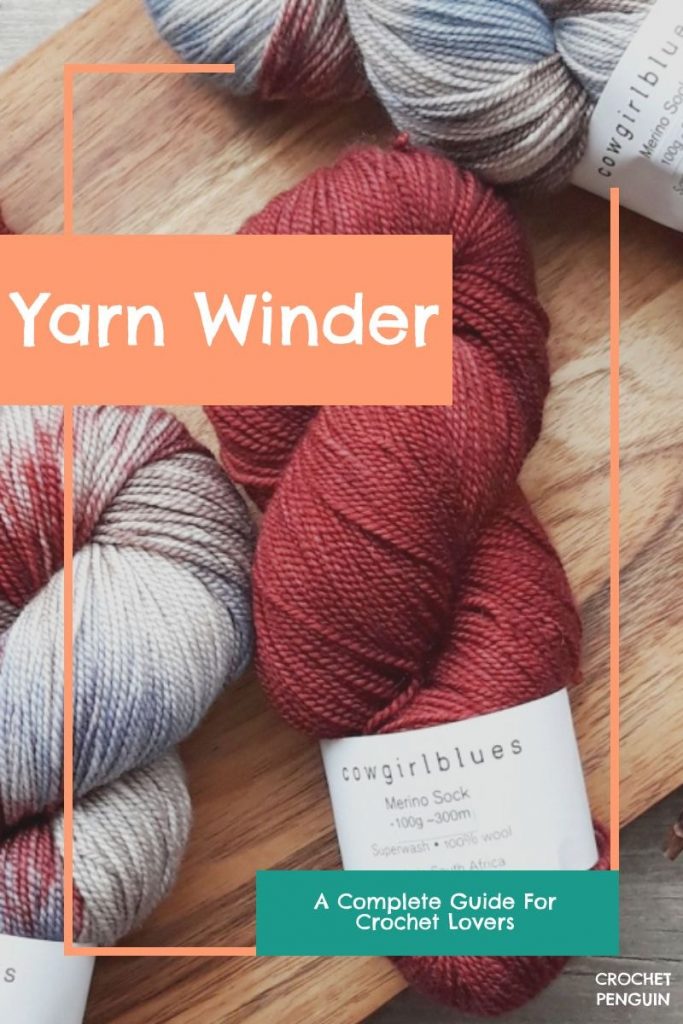Winding yarn from hanks into easy-to-use cakes by hand is time-consuming, hard, and annoying! Yarn Winders make this job easy. Here’s my review of the best. There are many types: wooden winders, electrical yarn ball winders, and hand-operated ones. Read the result of my research in these reviews of the best available.
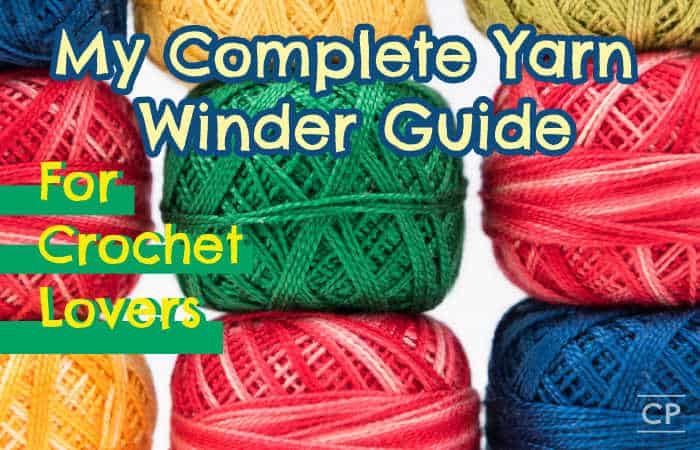
Note: If you click a link on this page and make a purchase, I may receive a commission, but at no extra cost to you. Learn More.
My Quick Recommendations
- My Top Pick – Lacis Jumbo Winder
- Best Budget Pick – Knit Picks Yarn Winder
- Best Luxury Option – Maple Jumbo Yarn Winder
I reviewed, fact checked and updated this post on April 12, 2023.
Table Of Contents
- The Best Yarn Winders
- Knit Picks Winder
- Maple Jumbo Yarn Winder
- Nostepinne
- Stanwood Needlecraft – 4 Ounce
- Beisaqi Winder
- Loops & Thread Winder
- Lacis Winder II
- Lacis Jumbo Winder
- What Is A Yarn Winder?
- How To Choose A Yarn Winder
- How To Use A Yarn Winder
The Best Yarn Winders
Here, I list the best yarn ball winder brands to suit any budget and the best heavy-duty yarn winder, plus many others.
Knit Picks Yarn Ball Winder
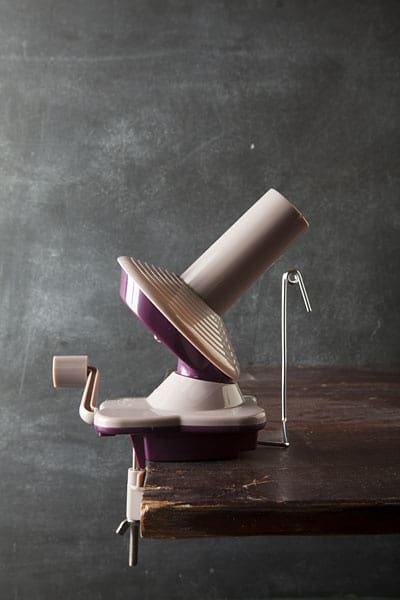
One of the most popular yarn winders when on a budget. The Knit Picks Yarn Winder is easy to use. It makes up to 3.5 oz yarn cakes. (Suited to light yarn weights and thinner fibers.)
Bulky weight yarns can be wound, but the skein may have to be done in two. A unique feature is it pivots and can change positions to be more comfortable. Made of plastic, this device is lightweight and low cost. Its small size is great for those with little room in their crafting space.
The printed directional arrows by the handle show which direction to turn. With this compact yarn winder, it’s clockwise. This company also sells tools and notions like stitch markers and a yarn swift that can be teamed with this.
Pros
- If you travel or wind yarn on the go, this is excellent
- Clamps to surfaces or a table edge without leaving marks
- Though it’s plastic, it’s sturdy and lasts. Some parts are metal
- Easy set-up and storage
- Great for beginners
- Excellent affordability
- User friendly and such fun!
- This ball yarn winder has a smooth operation
- Designed with comfort in mind, suitable for those with arthritis or tendonitis
- Has a yarn guide and yarn guide arm
- Minimal effort required to crank
- Won’t take up much space on your craft room table
- Manufactured in the United States
Cons
- Not as fast as bigger models
Maple Jumbo Winder

This is a quiet, effortless winder. Simple to assemble, it clamps to a table or on your workspace.
It’s portable, easy to use with a little practice in the beginning, with a charming appearance. One of the most popular machines on the market.
Suitable for all types of yarn. Know that you can wind the purchase of your more expensive yarns with ease. Maple Wood is on par with Beech wood in terms of durability. It winds approx 1 pound of fingering weight yarn, or ten ounces of worsted weight yarn.
Pros
- Easy turn handles reduce wrist strain for crafters
- Durable and long-lasting
- Smooth winding
- Designed and manufactured in the United States
- Smooth finish hard maple and premium maple veneered plywood parts
- One year guarantee
- Straightforward instructions with helpful information
- Replaceable parts
- Excellent way to inspect your yarn for knots and imperfections
- Receives 5 star rating from customers
- Lasts for many years
- Dimensions suit tabletop use
- Instruction video available
- Extra stability if clamped to the table
- Excellent attention to detail
Cons
- Needs cleaning if used frequently
- This costs more than other winders, but it’s definitely worth the investment
Nostepinne Yarn Ball Winder

Here’s a lovely hand-crafted Nostepinne, made from cherry or walnut with refined, rich wood grains. It’s less expensive than birch wood. It’s carved to be comfortable to use. It creates center pull cakes. It has grooves to make it easier to grip and a smooth texture.
Start with a hitch knot and attach the yarn to the top groove to start winding.You can sometimes mistake this for another tool called a Niddy Noddy.
Nostepinne Yarn Ball Winder – What Is It?
This is a unique ball winder and the lowest low-tech version you can find. It transforms yarn hanks and skeins into center pull yarn cakes, but you do the work yourself. The shapes of balls depend on the winding pattern of the wool. Sometimes it looks more like an egg.
A great choice if you want to wind yarn if you are on the go. The name comes from a Scandinavian word meaning “nest-stick.” It’s how people winded the yarn years ago. A thing of simplicity. Interested in winders from the past? Look at the info in my Antique Yarn Winder post.
Pros
- Saves space
- Portable
- Creates a compact center pull ball
- Buffered with varnish against scratches and damage
- Made in the USA
- Free shipping to the US
- Winder can hold 4oz of yarn
- Notches to attach the yarn to begin
- Great shopping experience
Cons
- Hard to grip for some
- Slow process
Stanwood Needlecraft Yarn Ball Winder – 4 Ounce

An excellent yarn winder for ease of use, it’s operated by hand and makes yarn cakes of up to 4 ounces. It clamps to many surfaces and furniture. Made of strong materials and a smooth, even hand crank system to wind skeins or hanks. This is the upgraded 4-ounce version.
For those of you who loved your Royal Ball Winder, this is a good alternative.
Pros
- Clamp range is about 1 and 3/4″
- Excellent quality strong materials
- Almost unbreakable metal crank
- Easy to crank
- Great value for money
- Affordable
- Multipe reviews with five stars
- Transform yarn into neat tidy cakes
- Simple to clamp on your work surface
- Suitable for winding up to 4 oz of yarn
Cons
- May have to cut larger skeins in two, which isn’t a big problem
Beisaqi Wool Winder
 Check Price on Amazon
Check Price on Amazon
Excellent portability, weight, and ease of storage. It’s designed for smaller balls. Simple to use. A metal yarn arm at the bottom extends to keep it steady as you hand crank. Winds yarns up to 3 oz hank or skein. Get ready for a tidy yarn skein!
Pros
- Lightweight
- Easy to transport and set up
- Quiet
- Convenient
- Great for beginners
- Winder can make smaller balls of less than 3 oz
Cons
- Confusing instructions
Lacis Yarn Ball Winder II
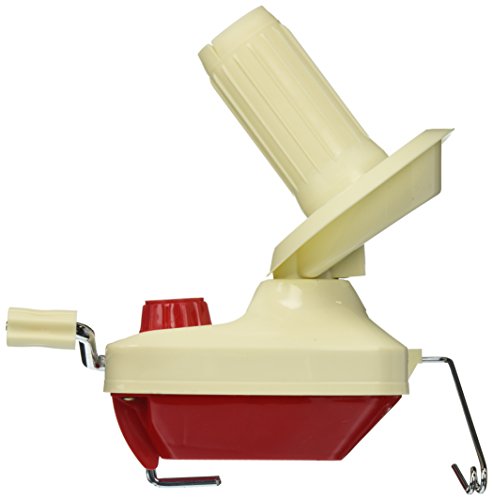 Check Price on Amazon
Check Price on Amazon
Excellent for using leftover yarn balls and scrap pieces to make neat cakes. It’s lightweight and portable and winds up to 4 ounces of yarn. Reworking skeins into cakes saves you from the tangled mess that sometimes happens when coming to the end of a skein.
The instruction’s content makes the simple assembly a breeze.
Pros
- Large spindle capacity
- Notch on the top of the spool to secure the yarn end
- Winds without needing cones or tubes
- The table clamp keeps it in place
- Leaves plenty of space on your workbench for crochet or knitting accessories
Cons
- The arm slips once a while
Lacis Jumbo Yarn Winder
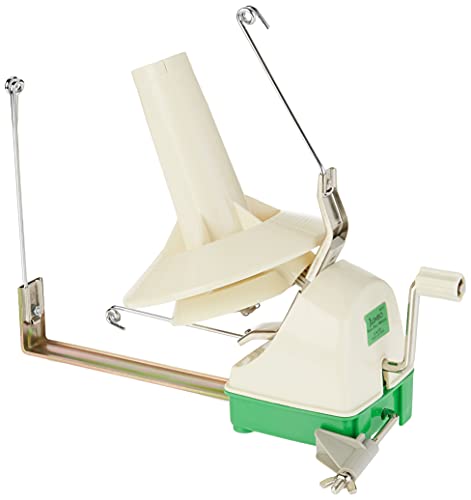 Check Price on Amazon
Check Price on Amazon
Winds up to 7 ounces for yarn balls. With its durability, it handles many yarns and weights, from lace to bulky. Set up is more complicated than other winders. Still, a screwdriver is included to make it easier. Transform a yarn hank loop or yarn skeins into neat center pull balls.
Pros
- Easy setup
- Great for winding for medium-sized projects
- Durable construction
- Smooth motion
- The frame is sturdy
- Has a useful yarn guide arm
- Low noise as it winds on the spindle
- No need to cut a large skein in half
Cons
- Wind slowly at the start
Loops & Thread Winder
 Check Price on Amazon
Check Price on Amazon
It comes fully assembled. Set it up on the surface, and you’re ready! The rest is simple to use and holds smaller balls of yarn. Some users experienced the yarn falling off the end as it has a different position for the spindle.
Be mindful of where you place the yarn when threaded and how you keep tension as you hold the ball of yarn you are winding from. A tension guide ring keeps the yarn tension in the winding process. Once you get the hang of it, you’ll achieve consistency.
Pros
- Easy to turn the handle
- Easy to set up on tables
- Great for knitters and crocheters
- Storage is no trouble
Cons
- The yarn gets caught around the spool if you wind too slowly
- Separate larger hanks into smaller amounts to fit them on the winder.
Windaze Yarn Ball Winder

This is often unavailable so if you’re looking for a small winder, try the Knit Picks Yarn Winder. Handles skeins of yarn up to 7oz. The wool winder holder works on table thickness up to 1.4″.
There are two metal swing arms. Use either one but not both at the same time. The second arm is a counterbalance.
Pros
- The design of the handle is ergonomic, for less strain on the wrists
- Mounts to any surface with an easy hand turn screw system
- Hand operated yarn winder that takes minimal effort
Cons
- If you go too fast, sometimes the yarn slips and gets tangled around the spool
- You need to use it slowly at first
- Tricky to set up
- Unclear instructions
Simplicity Boye Electric

A great electric yarn winder using 120v a/c electricity. The machine does the winding of yarn balls. Sit back and let it work! If you have wrist problems, or joint/muscle/bone fatigue, the Boye Electric is great. Its manual shows an example of how to set it up.
This winder isn’t often available. People also reported the electric motor using 120v a-c isn’t powerful enough. I’ve covered recommendations for alternative electric yarn winder options. Consider you’ll need a power outlet close by to set these up.
Stanwood Needlecraft Large Ball Winder – 10 Oz

This makes large yarn cakes with a yarn capacity of up to 10 oz. No need to cut large hanks into many piles! Despite being heavy-duty, it’s easy to assemble and store. Often used at Yarn Stores. It is the best yarn winder as it works with all weights and yarn, from wool, acrylic, cotton, cashmere, merino, and silk. The cakes are center-pull, neat, and compact. They fit in a yarn bowl.
The base is heavy metal, so it cranks out some serious winding. Bulky yarns are a breeze. Look out, messy yarn stash. Prepare to be organized! Note: The clamp is metal, so place a soft cloth on your surface to protect it. Unfortunately it’s not always available.
Pros
- This winder handles sizable yardage – large skeins up to 10 ounces
- Sturdy base of engineered metal steel, apart from the nylon cogs
- Designed to last years
- Little assembly needed as there are few components
- Simple to use
- Quiet cogwheels
- Smooth, even crank
- Base has anti skid rubber pads to protect areas beneath and prevent slipping
- Positive customer reviews
- Excellent if you do a good deal of yarn winding
- Receives excellent customer ratings
Cons
- Confusing to use at first, but it becomes easier.
Nancy’s Knit Knacks Heavy Duty Ball Winder
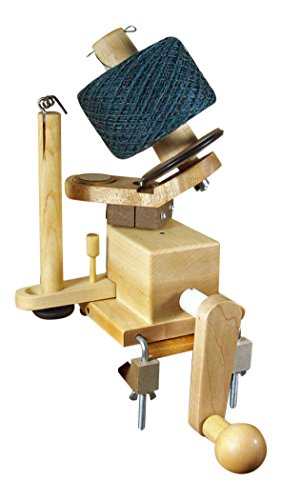
I was in touch with Pete Charles from The Oregon Wood Worker. He said the owner of Nancy’s Knit Knacks had passed away. The family hoped someone would buy it. So far, no one has.
I recommend one of these ergonomic design winders if you find it second-hand. I hope they reproduce these devices. Join my mailing list, so I can keep you updated.
The perfect heavy-duty winder. It winds up to one pound! (16 ounces.) Despite the size, it’s simple to use and requires little setup. Made from wonderful maple wood and swiss gears. It’s an investment, but it’s a tool anyone would be happy to display because it looks so beautiful.
These products are what you’d find in your local yarn store as it’s a workhorse and quiet. Many experts recommend this beauty for when you’re winding great quantities of yarn. The best yarn winder for heavy use.
What’s The Point Of A Yarn Winder?
It stops you from having to wind from chair backs! Like I’m demonstrating.

Here are other reasons.
- They make a boring task convenient and fast
- Useful for any crocheter, regardless of skill level
- Do you have lots of scrap yarn? Use the yarn ball winder to make them into cakes, ready to use for a project!
- Using a yarn winder tidies up unused or partial skeins/hanks of differing weights
- If you’re using a skein of yarn that changes colors, wool winders show where it starts and ends. It’s useful if you want to separate them into cakes of each color
- Use a yarn winder to create center-pull cakes, the best yarn form to crochet from. For some center pull makes a world of difference.
- These items conserve your energy and save time.
- Keeps your stash in order
- If you have pain in your wrists or hands, a yarn winder is just what you need.
Some of my readers made a DIY yarn winder. If you’re planning to do lots of winding, buy a product built to last. Some people ask, do I need a yarn swift? Yarn Swifts are certainly another handy tool that holds the ounces of yarn and spins freely as the winder winds beautiful yarn cakes. No more having to beg friends, your spouse/husband, and family to hold the yarn for you!
What Is A Yarn Winder?
A tool for winding yarn. They wind fibers into flat, neat cakes that pull from the center. The pull thread yarn balls don’t roll and stay in one spot.
How Do You Fix A Winder?
- First things first, do the following steps carefully.
- Twist the cone-shaped bobbin off the base of the yarn winder.
- Remove the screw from the plate underneath the bobbin. Remove the plate and put that bit to the side.
- The gears are probably out of alignment, and their teeth aren’t fitting together. Ease the larger gear back from the smaller one until they fit and the teeth mesh together.
- Get the plate, and screw it back on.
- Put the bobbin back. Done! Your yarn winder is good to go.

What Are Yarn Balls And Cakes?
I’ll give a quick comparison.
Balls
- Hand-wound balls move in all directions and pull from anywhere
- Slow and tedious
- Cumbersome because you need something to hold the hanks like the back of a chair
- If you pull straight from the skein, the yarn becomes tangled
- You can’t inspect the yarn for knots or frayed points
- The shape of the ball can be uneven
Yarn Winder Cakes
- A yarn muffin pulls from the center and spins in a neat circle with flat sides.
- The tail or end of the yarn is in the center, hence the name center-pull cake
- One crank of the handle is winding by hand 25 times. Different models have different speeds
- Keep your unwound yarn in one spot using an accompaniment tool, a yarn swift to hold it in one spot. Saves on having to find another person to hold the yarn.
- You can inspect for knots as you wind
- Depending on the capacity of the winder will determine the number of cakes created
How To Choose A Yarn Winder
Keep the following details in mind when considering a yarn winder. These questions will help you with your decision.
Hand Cranked Or An Electric Yarn Ball Winder?
Electric versions are more expensive and less portable, as they need to be plugged into power. The motor of these yarn winders makes noise. But they wind yarn for you! An electric yarn winder is an outlay but worth it if you wind lots of yarn.
Hand-cranked winders are cheaper, and you can set them up anywhere.
Do You Buy Hanks Or Skeins?
If you use hanks, invest in a winder and yarn swift. It keeps the yarn from tangling and threads the yarn to the winder as you crank. If you buy skeins, you don’t need to wind them, but if you prefer cakes, you can.
How Much Will You Spend?
Consider your budget for tools! Stick within your price range. Generally, the more expensive best yarn winders last for years. But there are quality cheaper ones which don’t cost a ton of money. Also, shipping is expensive. Prices can vary, so take up the advantage of any sales.
What Material Do You Prefer? Wood Or Plastic?
This is personal preference and taste. Plastic winders are cheaper, easier to assemble, and weigh less. Wooden yarn winders are expensive, harder to assemble. Still, they last longer and are sturdier. The gears are usually better protected. The life of your winder will depend on the care you take with it.
Manage Tension Yourself Or Have The Machine Do it?
If you hold the yarn while you wind, you get two benefits.
- You have control and can stop it if necessary, preventing tangles
- The cakes are much tighter. More can fit on one cake
Some models have features that can control the tension, but this is rare.
What Size Cakes Do You Need/Prefer?
The cheaper end usually holds 3.5-4 ounces of yarn. The average size is 5-8oz, with some high-quality yarn winders holding 10 oz. The largest I’ve seen holds up to 16 oz of yarn! Excellent of large blanket patterns requiring lots of wool.
Partial Or Whole Skeins?
Will you wind the skeins of yarn for one project at once, or a few and more as needed? If you do a lot of the former, you need 5-8 oz. If the latter, 4 oz is good.
Craft Store Winders
Major craft stores and retailers have options. I’ve reviewed these yarn winders in the following posts. They are mainly made of plastics: Michaels, Joann, Walmart, and Hobby Lobby.
Yarn Ball Winders: What To Look For
These considerations are helpful to make your choice:
- Is It Sturdy? – If you want quality to last years, you have to fork out more. Generally, plastic materials don’t last long.
- Can You Crank It Easily? – Ball winders should be easy to use, smooth, and not hard to pull. Even tension and speed are important. Otherwise, the yarn catches. Keep in mind to check if the hole is smooth.
- Is It Easy & Simple To Set Up? – You need something easy to set up at home, and so you can crochet immediately!
- Can It Keep Consistent Tension? – You shouldn’t have to keep a constant eye on it to see it doesn’t end up super tight or loose!
- Are The Gears Protected? – Yarn catching and snagging on gears is annoying. You want ball winders with well-protected gears, so there are no issues with tangling.
- Are The Table Clamps Steady? – They’re best when they clamp securely without damaging or leaving marks on the surface.
- Do You Have The Space To Accommodate This Model? – When paired in conjunction with a swift, yarn winders take up lots of room. Not everyone can accommodate such a big setup. Consider the measurements before buying!
How To Set Up Your Yarn Ball Winder
- Find a workbench in your craftroom or even your kitchen bench, counter top or dining table. Clear the area off.
- Place a cloth on the surface. Ensure there’s space for the waiting yarn to sit. The best distance between your yarn winder and wind swift is 12-18″.
- Clamp each instrument to the table, and tighten the bolts
Steps To Put The Yarn On The Swift
- Unwind the hank of yarn or skein and remove the ties, so it’s a ring of yarn. If you use scissors, be careful not to cut the actual yarn strands when removing the ties.
- Find the two ends, check they aren’t tangled. Less chance of hassles later!
- Most yarn swifts are the umbrella style. Push the button at the bottom of the pole upwards on the umbrella swift. The arms expand. A good idea is to do this with care.
- Some are the amish style. If so, put the yarn around the correct pegs width
- Place the ring around the arms.
- Adjust as necessary, so the yarn sits around the arms of the swift.
- Give the yarn end a little tug to check the swift spins freely
The Way To Connect The Yarn To The Winder
- Find the end on the outside.
- Slip it through the guide and the slot at the top of the winder bobbin/ spindle.
Steps To Create A Center-Pull Yarn Cake
- Start to wind the yarn and crank the handle of the yarn winder slowly. The yarn from the hank rotates, creating the center-pull cake.
- Use your other hand to guide the yarn to control the tension. It might take a couple of attempts to get this right.
- Increase the winding speed. Ensure everything is running smoothly and the winder and swift are working in combination with each other.
- You’ll have the results of your wonderful cake in no time at all!
Remove The Yarns From The Winder
- After you have finished winding your yarn, follow these steps
- Hold the thread with your pincher fingers at the slot at the yarn winders top part.
- Use your other hand to ease the yarn cake off the yarn winder.
- Unwind a length of yarn from the ball. Wrap the piece of yarn around the middle a few times and tuck in the end.
- Tada! You’re done!
- A great storage tip I found is to place the yarn label inside the center of the cake so you remember what the yarn is.
Conclusion
I hope this review helps you! Anything to make crocheting or knitting easier is at the top of my list. No matter if you’re a crocheter and a knitter, these tools are super helpful.
Do you have a yarn winder or considering buying one? Which looks the best for you? Feel free to ask a question in the comments. Of course, your email address is never published when I answer you. I’d love to hear your thoughts.
Pin For Later
